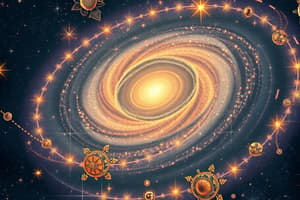Podcast
Questions and Answers
A spherical galaxy, like M87, which looks like a monster globular cluster, is type:
A spherical galaxy, like M87, which looks like a monster globular cluster, is type:
- E0 (correct)
- E1
- E2
- E7
The flattest of the ellipticals are class:
The flattest of the ellipticals are class:
- E7 (correct)
- E6
- E4
- E5
Which type of galaxy has a stellar disk, but without gas and dust?
Which type of galaxy has a stellar disk, but without gas and dust?
S0
You observe a spiral galaxy with a large central bulge and tightly wrapped arms. It would be classified an:
You observe a spiral galaxy with a large central bulge and tightly wrapped arms. It would be classified an:
The Milky Way is often considered to be an intermediately wound, barred spiral, which would be type ____ according to Hubble.
The Milky Way is often considered to be an intermediately wound, barred spiral, which would be type ____ according to Hubble.
Galaxies are classified into types solely on the basis of their color.
Galaxies are classified into types solely on the basis of their color.
Most of the galaxies in the Local Group are:
Most of the galaxies in the Local Group are:
What is the nearest huge cluster of galaxies to our Local Group?
What is the nearest huge cluster of galaxies to our Local Group?
What is the nearest huge cluster of thousands of galaxies, to which the Local Group may belong?
What is the nearest huge cluster of thousands of galaxies, to which the Local Group may belong?
Why does Cepheid 'standard candle' have limited usefulness beyond 20 Mpc?
Why does Cepheid 'standard candle' have limited usefulness beyond 20 Mpc?
Which of the following paraphrases Hubble's Law?
Which of the following paraphrases Hubble's Law?
What is true to spiral galaxies?
What is true to spiral galaxies?
According to Hubble's Law, the greater a galaxy's redshift, the:
According to Hubble's Law, the greater a galaxy's redshift, the:
While examining the spectrum of a galaxy you find all the hydrogen lines are shifted to longer wavelengths. This galaxy is:
While examining the spectrum of a galaxy you find all the hydrogen lines are shifted to longer wavelengths. This galaxy is:
Which of these would be made up of only Population II stars?
Which of these would be made up of only Population II stars?
Quasars usually have their distances measured by what technique?
Quasars usually have their distances measured by what technique?
That quasars were at cosmological distances yet appeared like ordinary faint stars meant:
That quasars were at cosmological distances yet appeared like ordinary faint stars meant:
In what sense are the quasars 'quasi-stellar'?
In what sense are the quasars 'quasi-stellar'?
Most active galactic nuclei are powered by:
Most active galactic nuclei are powered by:
Which of the following does the intensity of synchrotron radiation NOT depend on?
Which of the following does the intensity of synchrotron radiation NOT depend on?
The type of radiation coming from active nuclei due to electrons spiraling in very strong magnetic fields at relativistic speed is:
The type of radiation coming from active nuclei due to electrons spiraling in very strong magnetic fields at relativistic speed is:
Synchrotron radiation produces a(n) ________ spectrum.
Synchrotron radiation produces a(n) ________ spectrum.
Not only does the central engine of active galaxies and quasars require a black hole, but also _________ to provide the radiate energy.
Not only does the central engine of active galaxies and quasars require a black hole, but also _________ to provide the radiate energy.
A galaxy that was once a quasar is likely to
A galaxy that was once a quasar is likely to
The first clue to the significance of quasars came from the discovery that some of these 'stars' were much stronger radio sources than any normal star.
The first clue to the significance of quasars came from the discovery that some of these 'stars' were much stronger radio sources than any normal star.
Quasars can emit as much as thousands of times as much energy as normal galaxies.
Quasars can emit as much as thousands of times as much energy as normal galaxies.
Why is the energy source for active nuclei like Seyferts thought to be compact?
Why is the energy source for active nuclei like Seyferts thought to be compact?
In active galaxies, their central engines may be temporarily fed by:
In active galaxies, their central engines may be temporarily fed by:
If the redshift is an accurate indication of the distance to that galaxy, then this is considered a cosmological redshift.
If the redshift is an accurate indication of the distance to that galaxy, then this is considered a cosmological redshift.
The expansion of the universe means that stars in our Milky Way Galaxy are getting increasingly farther apart.
The expansion of the universe means that stars in our Milky Way Galaxy are getting increasingly farther apart.
Most galaxies are members of some sort of cluster of galaxies.
Most galaxies are members of some sort of cluster of galaxies.
Which statement about the Local Group is FALSE?
Which statement about the Local Group is FALSE?
Irregular galaxies, although small, have large H II regions and much ongoing star formation for their size.
Irregular galaxies, although small, have large H II regions and much ongoing star formation for their size.
Flashcards are hidden until you start studying
Study Notes
Galaxy Classification
- Spherical galaxies like M87 are classified as E0, resembling globular clusters.
- The flattest elliptical galaxies are classified as E7.
- Galaxies with a stellar disk but lacking gas and dust are categorized as S0.
- A spiral galaxy with a large central bulge and tightly wound arms falls under type Sa.
- The Milky Way is classified as an SBb, indicating it is an intermediate, barred spiral galaxy.
Hubble's Law and Distance
- Hubble's Law states that the greater the distance to a galaxy, the greater its redshift, indicating it is moving away.
- Cepheid variables, known as "standard candles," lose their effectiveness for distances beyond 20 Mpc due to their faintness at such ranges.
- The nearest huge cluster to the Local Group is the Virgo Cluster, which houses thousands of galaxies.
Properties of Galaxies
- Most Local Group galaxies are small ellipticals, akin to companions of M31 (Andromeda).
- Spiral galaxies are rare in regions of high galaxy density, indicating environmental influences on galaxy formation.
- Elliptical galaxies are composed solely of Population II stars, characterized by older stars.
Quasars and Active Galactic Nuclei
- Quasars are measured using Hubble's Law, suggesting they are at cosmological distances while appearing like ordinary faint stars.
- Their immense energy output challenged theories, as even fusion couldn't account for their luminosity.
- Active galactic nuclei are typically powered by supermassive black holes and have a continuous nonthermal spectrum from synchrotron radiation.
Synchrotron Radiation
- Synchrotron radiation occurs when electrons spiral in strong magnetic fields, producing a spectrum reliant on factors excluding temperature.
- Central engines of active galaxies require an accretion disk of infalling matter to radiate energy.
Active Galaxy Dynamics
- A galaxy that once exhibited quasar characteristics likely contains a black hole at its nucleus.
- Active galaxies may temporarily feed their central engines through close encounters with neighboring galaxies.
- The statement that most galaxies belong to clusters is true, reinforcing the interconnected nature of galaxies in the universe.
Misconceptions
- The expansion of the universe does not imply that stars within the Milky Way are moving farther apart from each other.
- The Local Group does not include the large radio galaxy Centaurus A, which is a false statement about its composition.
- Irregular galaxies, despite their small size, exhibit significant ongoing star formation in large H II regions.
Studying That Suits You
Use AI to generate personalized quizzes and flashcards to suit your learning preferences.




